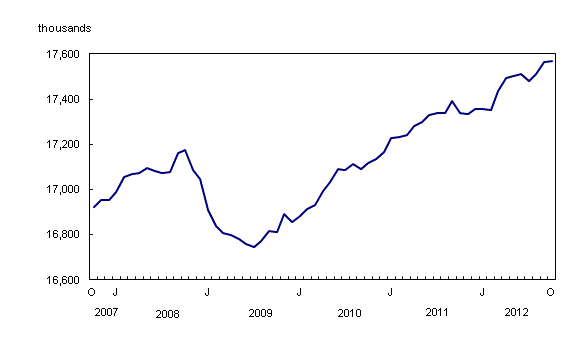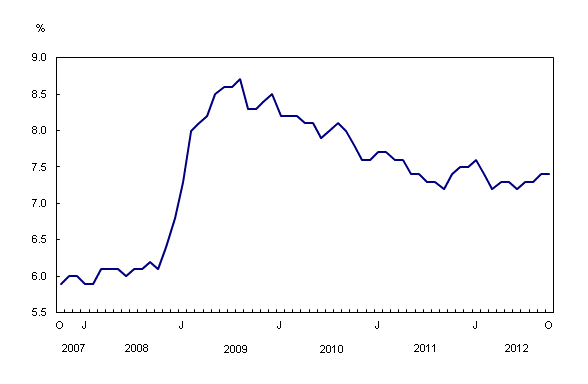Labour Force Survey, October 2012
Archived Content
Information identified as archived is provided for reference, research or recordkeeping purposes. It is not subject to the Government of Canada Web Standards and has not been altered or updated since it was archived. Please "contact us" to request a format other than those available.
Related subjects
-
[an error occurred while processing this directive]
Following two consecutive months of increases, employment in October was unchanged and the unemployment rate remained at 7.4%.
Employment

Compared with 12 months earlier, employment increased 1.3% or 229,000, all in full-time work. The total number of hours worked also rose 1.3% over the same period.
In October, employment grew in Quebec and Newfoundland and Labrador, while it fell in British Columbia and Manitoba. There was little change in the other provinces.
The number of public sector employees increased by 37,000, offset by a decline in private sector employment, which includes both private sector employees and the self-employed. Total gains over the previous 12 months were among both private sector employees (+157,000 or +1.4%) and public sector employees (+74,000 or +2.1%).
Employment in agriculture experienced a decline in October, while there was little change in the other industries.
The number of workers among the major demographic groups was virtually unchanged in October.
Unemployment rate

Chart description: Unemployment rate
Provincial summary
Employment in Quebec increased by 20,000 in October, all in part-time work, pushing the unemployment rate down 0.3 percentage points to 7.7%. Compared with 12 months earlier, employment in the province was 1.7% higher.
In October, employment in Newfoundland and Labrador rose by 3,800, and the unemployment rate was 11.9%. Employment in the province increased 3.6% from 12 months earlier, the highest growth rate among the provinces.
The number of workers in British Columbia declined by 11,000 in October. Nevertheless, the unemployment rate fell 0.3 percentage points to 6.7%, as fewer people participated in the labour force. Year-over-year employment growth for the province was 1.3%.
Following two consecutive months of increases, employment in Manitoba fell by 7,300 in October, and the unemployment rate rose 0.6 percentage points to 5.6%. Despite this increase, Manitoba continued to have one of the lowest unemployment rates among the provinces. Compared with 12 months earlier, there was little change in overall employment.
In October, employment in Ontario was little changed, as a decrease in part-time work was mostly offset by an increase in full-time work. The unemployment rate rose 0.4 percentage points to 8.3%, as more people searched for work. Compared with 12 months earlier, employment growth in the province was 1.0%.
While employment in New Brunswick was little changed in October, the unemployment rate increased 0.6 percentage points to 11.6%, with more people searching for work. Compared with 12 months earlier, the unemployment rate in the province was up 2.2 percentage points.
Employment losses in agriculture
Following an increase in September, employment in agriculture fell by 16,000 in October. Employment in this industry was little changed compared with 12 months earlier.
The number of workers in manufacturing was little changed for the fifth consecutive month. Compared with 12 months earlier, the number of factory workers increased 5.2%, with most of the gains earlier in the year.
Little employment change among the major demographic groups
In October, employment among men aged 55 and over was little changed. However, with more men in this age group searching for work, the unemployment rate increased 1.0 percentage points to 7.3%. Compared with 12 months earlier, employment among this group was up 87,000 (+5.1%), partly as a result of population aging.
Employment among women aged 55 and over was little changed in October. Compared with 12 months earlier, their employment increased by 102,000 (+7.4%), also partly a result of population aging.
Employment among those aged 25 to 54 was unchanged in October, and the year-over-year gains were 92,000 (+0.8%).
Employment among youths was little changed for the second consecutive month and was down by 52,000 (-2.1%) compared with 12 months earlier. Their unemployment rate was 14.7% in October.
Note to readers
The Labour Force Survey (LFS) estimates are based on a sample and are therefore subject to sampling variability. Estimates for smaller geographic areas or industries will have more variability. For an explanation of sampling variability of estimates and how to use standard errors to assess this variability, consult the "Data quality" section of the publication Labour Force Information (Catalogue number71-001-X, free).
The employment rate is the number of employed persons as a percentage of the population 15 years of age and over. The rate for a particular group (for example, youth aged 15 to 24) is the number employed in that group as a percentage of the population for that group.
The unemployment rate is the number unemployed as a percentage of the labour force (employed and unemployed).
The participation rate is the number of employed and unemployed as a percentage of the population. For more detailed information, see the Guide to the Labour Force Survey (Catalogue number71-543-G, free).
Unless otherwise stated, this release presents seasonally adjusted data, which facilitates comparisons by removing the effects of seasonal variations. For more information on seasonal adjustment, see Seasonal adjustment and identifying economic trends.
Available without charge in CANSIM: tables CANSIM table282-0001 to 282-0042, CANSIM table282-0047 to 282-0051, CANSIM table282-0054, CANSIM table282-0055, CANSIM table282-0060 to 282-0063, CANSIM table282-0069 to 282-0089, CANSIM table282-0092 to 282-0095, CANSIM table282-0100 to 282-0121 and CANSIM table282-0200 to 282-0219.
Definitions, data sources and methods: survey number survey number3701.
A more detailed summary, Labour Force Information (Catalogue number71-001-X, free), is now available online for the week ending October 13. From the Key resource module of our website under Publications, choose All subjects, then Labour.
Data tables are also now available online. From the Subject module of our website, choose Labour.
The next release of the Labour Force Survey will be on December 7.
For more information, contact us (toll-free 1-800-263-1136; infostats@statcan.gc.ca).
To enquire about the concepts, methods or data quality of this release, contact Vincent Ferrao (613-951-4750; vincent.ferrao@statcan.gc.ca) or May Luong (613-951-6014; may.luong@statcan.gc.ca), Labour Statistics Division.
- Date modified:
